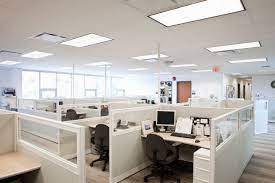What Is The Difference Between A Desk And A Workstation?
The terms “desk” and “workstation” are often used interchangeably, but there are some differences between the two. In general, a desk is a simple piece of furniture that is used for writing, reading, or other tasks, while a workstation is a more complex setup that is designed for specific tasks, such as computer work. In this article, we will explore the differences between a desk and a workstation, and also discuss how cubicles for call center are used in call centers.
A desk is a simple piece of furniture used for general work, while a workstation is a more complex setup designed for specific tasks. Workstations may include specialized equipment and ergonomic features, and are often used for computer work, drafting, or manufacturing. Cubicles are small, enclosed workspaces often used in office settings to provide privacy and reduce distractions. Workstation cubicles, commonly found in call centers, are designed to be functional and efficient, with features such as sound-absorbing panels, adjustable height desks, and integrated storage space for reference materials and other tools.
Definition Of A Desk
A desk is a piece of furniture that typically consists of a flat surface, supported by legs or a base, on which a person can work or perform various tasks. Desks can be made from a variety of materials, including wood, metal, and plastic, and can come in many different styles and sizes.
Desks are generally used for tasks such as writing, reading, drawing, and other general work. They may have drawers, shelves, or other compartments for storage, and may be used in a home office, a school, a library, or other setting.
Definition Of A Workstation
A workstation, on the other hand, is a more complex setup that is designed for specific tasks, such as computer work, drafting, or manufacturing. A workstation typically consists of a desk or work surface, as well as specialized equipment and accessories that are designed to support the specific task at hand.
For example, a computer workstation might include a desk or table, a computer monitor, a keyboard and mouse, and a printer. A drafting workstation might include a drafting table, a T-square, and drafting tools. A manufacturing workstation might include a workbench, specialized tools, and safety equipment.
Differences Between A Desk And A Workstation
The main difference between a desk and a workstation is the complexity and functionality of the setup. A desk is generally a simple piece of furniture that is used for general work, while a workstation is a more specialized setup that is designed for specific tasks.
Another difference is that a workstation often includes specialized equipment and accessories that are designed to support the specific task at hand. A computer workstation, for example, may include a monitor arm, a keyboard tray, and cable management systems to help organize cords and cables.
Finally, a workstation may also include ergonomic features that are designed to promote comfort and safety during extended periods of use. This can include features such as adjustable height, lumbar support, and footrests.
Definition Of A Cubicle
A cubicle is a small, enclosed workspace that is typically used in office settings. Cubicles are often used to divide a larger space into smaller, individual work areas, and are designed to provide privacy and reduce distractions.
Cubicles typically consist of three walls and a ceiling, and may include a desk or work surface, a chair, and storage space. They are often made from modular components that can be easily assembled and disassembled, and can be customized to meet the specific needs of the user.
Cubicles In Call Centers
Cubicles are commonly used in call centers, which are large facilities where agents answer and make phone calls on behalf of a company or organization. Call center cubicles are typically designed to be functional and efficient, with features that help agents work more effectively.
For example, call center cubicles may include features such as sound-absorbing panels to reduce noise levels, adjustable height desks to promote ergonomic comfort, and integrated storage space for reference materials and other tools.
Conclusion
In summary, while the terms “desk” and “workstation” are often used interchangeably, there are some important differences between the two. A desk is a simple piece of furniture that is used for general work, while a workstation is a more complex setup that is designed for specific tasks


